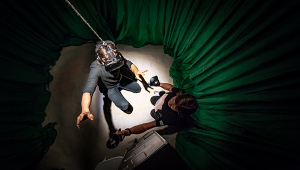Three Bristol-based projects have been recognised as among the world’s leading extended reality (XR) installations.
Last year respected American business publication Forbes Magazine looked at the growth of XR, which combines real-and-virtual combined environments and human-machine interactions. 
It identified 35 of the world’s best projects that are using XR to redefine how we think about space, narrative, technology and the relationship between creator and audience through computer technology and wearables.
Putting Bristol at the heart of XR are three projects linked to the city’s Pervasive Media Studio, part of Watershed media centre.
Two of the installations – Only Expansion and The Collider – have received support from the studio, which brings together a diverse community of more than 100 artists, creative companies, technologists and academics exploring experience design and creative technology. The studio is run in partnership with the University of Bristol and UWE Bristol.
The third installation – Through the Wardrobe – has been developed with the support of UWE’s Digital Cultures Research Centre, based at the studio.
Only Expansion is a site-responsive audio tour developed by artist Duncan Speakman working with mobile audio in uncontrolled public and private spaces in the Pervasive Media Studio.
The installation remixes the sound of the city around the user to experience sonically how their own life might change in the future. As field recordings of climate collapse blend into their surroundings, they begin to hear the city as if it was under water or beaten by dry desert winds.
It has been described as a visceral and poetic reflection on what it means to live on a planet in crisis,
Duncan’s current PhD Research is in the compositional structures of locative audio works and their relationship to current ecological debate.
The Collider has been developed by Anagram, a creative company specialising in interactive storytelling and immersive experiences for festivals and museums that straddles the worlds of art and technology.
The Collider decodes the mysteries of human relationships with a mission is to identify and understand the invisible material that passes between people that keeps us together and pulls us apart. Created for two people at a time, each participant is invited to reconstruct a memory of feeling either powerful or powerless inside a glass display stand – using an array of miniature figurines, props and paper.
It has been described as “a dance between two limited humans failing and failing again to see the other’s experience and then, finally, the rush of connection when they do”.
PhD researcher Rob Eagle augmented reality (AR) wardrobe challenges ideas about fashion and identity and introduces audience-members to the lived experiences of Bristolian genderqueer and non-binary people.
It invites viewers to explore a wardrobe of clothes and play with the idea of gender expression using clothing selected by four genderqueer participants and an AR headset.
Rob Eagle said: “I wanted users to have a physical experience as well as a virtual one. The work relies on the power of touching physical objects whilst harnessing the creative freedoms of the augmented reality headset. The work challenges gender norms and asks questions about why people make particular decisions about the way they dress.”
The installation was assembled with help from four genderqueer participants inspired by their own stories and fashion choices. Many of the items came from charity shops and vintage stores in and around Bristol. For trans, gender-nonconforming and non-binary people, charity shops are one of the few non-gendered places to buy clothes on the high street.






























